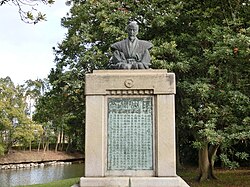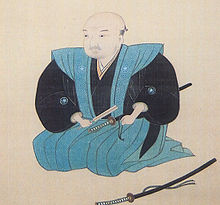Yamaga Soko
Yamaga Sokō ( Japanese 山 鹿 素行 ; born September 21, 1622 in Aizu District (会 津) in Iwashiro Province ; died October 23, 1685 ) was a Japanese scholar of the early Edo period .
life and work
Yamaga Soko received his education at the school of the Confucianist Hayashi Razan . At the age of 30 he became a military instructor of the Akō-han. In 1660 he opened his own school for classical and military training in Edo . He rejected the neo-Confucian teachings of Zhu Xi and taught the original teachings of Confucius .
In 1665 Yamaga published "The Essence of the Sacred Doctrine" (聖教 要 録, Seikyō yōroku), with which he questioned the validity of accepted interpretations of Confucian thought and attacked the ideological foundations of the Tokugawa shogunate. The book was banned by the shogunate, Yamaga had to leave Edo, but was later pardoned.
It was thanks to Yamagas to have initiated the return to the original teaching "Kogaku" (古 学) of Confucius. In the field of military science, he combined the use of European firearms with traditional Chinese tactics. His greatest contribution, however, was the development of a samurai ethic and his patriotic view of Japanese history. In 1656 he published the work "The essence of the doctrine of chivalry" (武 教 要 録, Bukyō yōroku), which is regarded as one of the earliest representations of the Bushidō . He presented u. a. states that in peacetime it is the duty of the samurai to serve as a role model in the service of the nation.
In his work on Japanese history, Yamaga was primarily concerned with strengthening national pride, patriotism, at a time when other scholars were exclusively concerned with China. In his best-known historical work "The Truth about the Chinese Empire" (中朝 事 実, Chūchō jijitsu) from 1669, he ridiculed the worshipers of China and established with examples that Japan surpassed other nations in many areas. His emphasis on the Shinto belief and the uninterrupted line of the imperial family were taken up again in the context of the Meiji Restoration and remained valid until 1945.
Remarks
- ↑ Monument on the railing of Akō Castle .
- ↑ Today part of Fukushima Prefecture .
literature
- S. Noma (Ed.): Yamaga Sokō . In: Japan. An Illustrated Encyclopedia. Kodansha, 1993, ISBN 4-06-205938-X , p. 1726.
Web links
| personal data | |
|---|---|
| SURNAME | Yamaga, Soko |
| ALTERNATIVE NAMES | 山 鹿 素行 (Japanese) |
| BRIEF DESCRIPTION | Japanese scholar |
| DATE OF BIRTH | September 21, 1622 |
| PLACE OF BIRTH | Aizu District Iwashiro Province |
| DATE OF DEATH | October 23, 1685 |

